 |

|
Punica
|
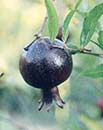 Sun
Sun Zone: 7-10 Zone: 7-10  90" tall 90" tall  Origin: Europe, Asia Origin: Europe, Asia
Open House/Web-Only!
This is the tallest of two seedlings we selected in 1986, from a batch of dwarf pomegranate seedlings. It survived our 9 degrees below zero F winter with minimal damage. This deer-resistant form was selected for its large size, hardiness, and giant, nearly black fruit...resembling an eight ball...great for the edible garden...as long as you aren't concerned with taste! Pot size: 24 fl. oz (709.77 ml) #01731
|
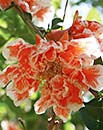 Sun
Sun Zone: 7b-10, at least Zone: 7b-10, at least  120" tall 120" tall  Origin: Europe, Asia Origin: Europe, Asia
Open House/Web-Only!
We have long prized pomegranates for their garden value, and no cultivar has drawn more questions than the Japanese cultivar 'Nochi Shibari', which means "large snotty orange tissue with a white topping"...just kidding. It actually means "bound or tied-up tail"...I'll leave it to your imagination as to why. This vigorous clone makes a 10' tall, deer-resistant shrub with small, narrow, glossy green leaves. Starting in June, Punica 'Nochi Shibari' is adorned with unique flowers...think orange carnation boutonnieres on both steroids and Ecstasy. The thick, waxy, orange calyx holds the double orange flowers, which are tipped in white. If you are into weird, don't let this offering pass you by. Pot size: 24 fl. oz (709.77 ml) #06659
|
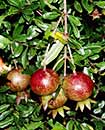 Sun
Sun Zone: 7-10 Zone: 7-10  60" tall 60" tall  Origin: Europe, Asia Origin: Europe, Asia
Open House/Web-Only!
This Plant Delights selection of pomegranate is the hardiest, best-flowering, and heaviest-fruiting selection we have seen. Throughout the summer and into the fall, Punica 'State Fair' is adorned with hundreds of bright orange, tubular flowers, followed by many dwarf pomegranates...to silver dollar size...a truly wonderful deer-resistant conversation piece. If no one wants to have a conversation, throw a few fruits at your guests and start one! Pot size: 24 fl. oz (709.77 ml) #01730
|
|
Puya
|
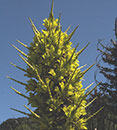 Sun to Part Sun
Sun to Part Sun Zone: 7b-9 Zone: 7b-9  18" tall 18" tall  Origin: Chile Origin: Chile
NEW!
Puya chilensis, which hails from the dry deserts of Chile at elevations up to 3000', is one of the few species of spiny bromeliads to survive long term (since 2005) in our garden. The 3' wide spiny rosettes...and I really mean spiny, may take up to two decades to flower, but like all good things it's worth the wait. The 6' tall flower spikes resemble otherworldly, oversized, lime green medieval mace clubs. In areas where it is happy, Puya chilensis will slowly form a large colony, but here, where we burn back the foliage below 10 degrees F, it will probably never get that large. A south or west sloped exposure where it gets sun during the day and stays dry in the winter, is the key to success. Don't plant outdoors after August from Zone 8 north. Pot size: 24 fl. oz (709.77 ml) #09122
|
|
Pycnanthemum
|
 Sun
Sun Zone: 6-8, at least Zone: 6-8, at least  36" tall 36" tall  Origin: USA Origin: USA
Open House/Web-Only!
(aka: Pycnanthemum tenuifolium A3T-035) We passed many colonies of narrow-leaf mountain mint as we traversed southeastern Texas in spring 2003 looking for Space Shuttle debris...just kidding. It was only when we saw this incredible clump in flower near Cat Springs that we deposited a couple of inches of rubber on the Texas highway and sent a tailgating pickup into the ditch, all while reducing the groundhog population by one. Was it worth it? Yes! This marvelous deer-resistant form of the clumping Pycnanthemum tenuifolium makes a 3' tall clump of narrow green foliage with the strong fragrance of spicy peppermint. In mid-June, the clumps are topped with large, pure white flower clusters...a dramatic improvement over the typically offered forms. Plant one near your vegetable garden to attract hoards of beneficial insects. Pot size: 24 fl. oz (709.77 ml) #05666
SOLD OUT
|
|
Pyrrosia
|
 Part Sun to Shade
Part Sun to Shade Zone: 7b-10 Zone: 7b-10  12" tall 12" tall  Origin: China, Japan, Taiwan Origin: China, Japan, Taiwan
Open House/Web-Only!
I know these don't look like ferns, but I'm not the taxonomist. They also aren't supposed to be hardy, but ours have been in the ground for over 10 years. The rhizome grows along the ground, and the leaves arise singly from it. The leaves have a unique, cardboard-like texture with a felty backside and eventually make a nice evergreen mass. Visitors will scratch their heads...you can scratch their backside...the ferns, of course. Pot size: 24 fl. oz (709.77 ml) #00977
|
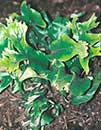 Part Sun to Shade
Part Sun to Shade Zone: 7b-10 Zone: 7b-10  12" tall 12" tall  Origin: China, Japan, Taiwan Origin: China, Japan, Taiwan
This rare crested form of the tongue fern is among the most beautiful of the ferns we grow. Each dark green cardboard-textured frond, which emerges from the thin surface-growing rhizome, looks like a reindeer head after a bad experience with a four-wheel drive pickup...nice antlers, but sort of twisted out of shape. Grow this evergreen fern in a well-drained site on a slope for best performance. Pot size: 24 fl. oz (709.77 ml) #01507
|
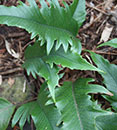 Light Shade
Light Shade Zone: 7b-10 Zone: 7b-10  7" tall 7" tall  Origin: China, Japan Origin: China, Japan
NEW!
This hard-to-find selection of tongue fern is also hard to describe. The fuzzy, green, tongue-shaped leaves look like what you would imagine if you stuck your tongue into an electrical socket. Each leaf has bizarre protuberances along the edge as if it had been cut with a pair of pinking shears. Although Pyrrosia lingua is usually epiphytic in the wild, spreading by a thin but almost woody rhizome, we have found it grows best in the garden if the soil is organically rich and the grade is sloped. Pyrrosia 'Hiryu' also makes an easy-to-grow container plant. Pot size: 24 fl. oz (709.77 ml) #08923
|
 Part Sun to Light Shade
Part Sun to Light Shade Zone: 7b-10 Zone: 7b-10  12" tall 12" tall  Origin: China, Japan, Taiwan Origin: China, Japan, Taiwan
Open House/Web-Only!
This Japanese selection of the evergreen tongue fern has been hardy for over 10 years in our garden. The growth habit is similar to the species, forming a dense colony to 2' wide in 5 years, thanks to a short creeping rhizome. Pyrrosia lingua cultivars hate growing flat and must be planted on a slope to thrive in cold climates. Pyrrosia 'Ogon Nishiki' has thick, green, vertically-held leaves with diagonal, butterscotch-yellow banding...picture an anorexic run over by a yellow Volkswagen, and you get the picture. Each 1' long x 2" wide, upright, tongue-shaped leaf would make Gene Simmons proud. Pot size: 24 fl. oz (709.77 ml) #01370
|
|
Rabdosia
|
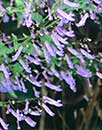 Part Sun to Light Shade
Part Sun to Light Shade Zone: 6-8 Zone: 6-8  36" tall 36" tall  Origin: Japan Origin: Japan
(syn: Plectranthus longitubus) I'll bet you never thought of growing rabdosia before...right? From the Japanese mountains of Honshu, Shikoku, and Kyushu comes this woodland member of the salvia family. The stems of this clumper rise throughout the summer reaching 2' tall by September, when they are topped with 1' long, airy panicles containing hundreds of pendent, purple tubes. This is as hard to describe as it is to pronounce, but finding anything that flowers in the fall woodland is difficult...simply superb! Pot size: 24 fl. oz (709.77 ml) #05413
|
 Part Sun to Light Shade
Part Sun to Light Shade Zone: 6-8 Zone: 6-8  36" tall 36" tall  Origin: Japan Origin: Japan
Open House/Web-Only!
This new color form of trumpet spurflower was discovered in Japan, then imported and named by plant guru Barry Yinger. Rabdosia 'Tube Socks' makes an upright, 3' tall x 2' wide clump of thin green stems adorned with green leaves. Just when you are wondering why you purchased it, the clumps explode with terminal clusters of small white flowers in mid-October. If you would like to brighten the fall woodland garden, I can't think of anything better than scattering "tube socks" throughout. Pot size: 24 fl. oz (709.77 ml) #06578
|
|
Ranunculus
|
 Sun to Light Shade
Sun to Light Shade Zone: 4-9 Zone: 4-9  4" tall 4" tall  Origin: S. Europe Origin: S. Europe
Open House/Web-Only!
For Winter Open House visitors to the garden, this is certainly the most talked-about plant we grow. This deer-resistant spring ephemeral emerges in February with rounded, glossy black foliage in a 6" wide rosette that hugs the ground. From late February through late March (in NC), the clumps are topped with brilliant yellow, 1" flowers held on 3" stalks just above the foliage. The stark contrast between the foliage and flowers is well expressed in the name given by its introducer, the late Christopher Lloyd "Brazen Hussy." Ranunculus 'Brazen Hussy' goes dormant by May, so be sure and mark your clumps for next spring. Unlike the species Ranunculus ficaria, the cultivars are not weedy! Pot size: 24 fl. oz (709.77 ml) #04557
|
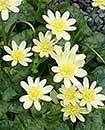 Sun to Light Shade
Sun to Light Shade Zone: 5-9 Zone: 5-9  4" tall 4" tall  Origin: S. Europe Origin: S. Europe
Open House/Web-Only!
Ranunculus ficaria 'Randall's White' is one of the many wonderful rock garden cultivars of an otherwise noxious weed. This selection comes from Allan Robinson, former Rock Garden Superintendent at Wisley, who named it for his cat. Ranunculus 'Randall's White' emerges for us in mid-February and comes into flower in mid-March. The 3" tall x 6" wide deer-resistant clump is composed of quarter-sized, heart-shaped, glossy green leaves, highlighted by a dramatic silver pattern. The 1" creamy daisies emerge on 3" stalks and age to white with a bright yellow center. By late May, the plants are asleep for the summer. Pot size: 24 fl. oz (709.77 ml) #06997
|
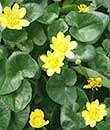 Sun to Part Sun
Sun to Part Sun Zone: 5-9 Zone: 5-9  10" tall 10" tall  Origin: S. Europe Origin: S. Europe
Open House/Web-Only!
For late winter and early spring flowering in the garden, it's hard to beat the lesser celandines. These deer-resistant buttercups first appear in February and disappear completely by the end of May. Ranunculus ficaria ssp. ficariiformis is one of the largest of the celandines, making a 10" tall x 1' wide clump. The glossy green 2" round foliage is topped in late February and March by 1" bright yellow daisies, held above the foliage. While the straight species is much too weedy to grow, we have not found this the case with this special form, shared with us by plantswoman Pam Harper over 12 years ago. Pot size: 24 fl. oz (709.77 ml) #03455
|
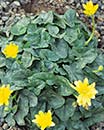 Sun to Light Shade
Sun to Light Shade Zone: 4-9 Zone: 4-9  2" tall 2" tall  Origin: Europe Origin: Europe
Open House/Web-Only!
This selection of the winter flowering Ranunculus ficaria makes a tight clump of quarter-sized green leaves, mottled with an irregular silver pattern. The clumps are topped from late February through late March with 2" tall stalks of double yellow flowers. Each 8" wide deer-resistant clump emerges in late January and goes dormant by late May. Pot size: 24 fl. oz (709.77 ml) #08606
|
|
Rehmannia
|
 Sun to Part Sun
Sun to Part Sun Zone: 7-10, at least Zone: 7-10, at least  24" tall 24" tall  Origin: China Origin: China
New crop available 9-2-2010 (syn: R. angulata) Visitors have fallen in love with this easy-to-grow groundcover member of the scrophularia family. In loose, moist soils, rehmannia will spread to make a nice mat of closely-spaced rosettes. From late spring through midsummer, the rosettes are topped with 2' tall stalks dripping with massive, pinkish-purple penstemon-like flowers... each with yellow specks deep in the throat. Flowering is heaviest in late spring, then sporadic in the summer...OUTSTANDING! Rehmannia is named in honor of the Russian physician, Joseph Rehmann (1799-1831). Pot size: 24 fl. oz (709.77 ml) #00422
SOLD OUT
|
|
Remusatia
|
 Part Sun to Shade
Part Sun to Shade Zone: 7b-10 Zone: 7b-10  36" tall 36" tall  Origin: Himalayas, Australia, Africa alternate image Origin: Himalayas, Australia, Africa alternate image
This bizarre genus of easy-to-grow aroids usually occurs in the wild as epiphytes (growing without soil on trees or rocks). Despite this alternate lifestyle, R. vivipara makes a superb garden plant in the soil as well. In late spring, the very glossy green leaves emerge, forming a dwarf clump to 2-3' tall. Once the tuber is large enough, the new foliage will be accompanied by cool, fragrant, yellow flowers. In late summer, remusatias show why they were banished into a separate genus with their bizarre stolons that arise from the tuber and grow erect to 10" tall. Each stolon is laden with tiny fuzzy hooked tubercles (bulbils in need of a shave), which can be used to propagate more plants. In Third World countries, a rub derived from the tubers is used to treat arthritic pain. If you like unusual plants, this is a must! Pot size: 24 fl. oz (709.77 ml) #04440
|
|
Rhapidophyllum
|
 Sun to Light Shade
Sun to Light Shade Zone: 6-10 Zone: 6-10  100" tall 100" tall  Origin: USA Origin: USA
The hardiest of palms, this slow-growing Florida native has withstood -9 degrees F here with NO damage (without protection or special siting). We expect established specimens should handle -20 degrees F. This short-trunked clump-former has typical cut-leaf, green palm foliage and sharp "needles" at the base to protect the seeds...very rare! In marginal climates, plant needle palms early in the season and protect them the first couple of winters until they become well-established. In colder climates, we recommend up-potting young plants and keeping them indoors until they are larger.
Pot size: 24 fl. oz (709.77 ml) #01087
|
|
Rhexia
|
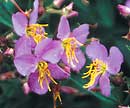 Sun to Part Sun
Sun to Part Sun Zone: 3-9 Zone: 3-9  12" tall 12" tall  Origin: USA Origin: USA
Open House/Web-Only!
This commonly seen US native, from Canada south to Florida, is surprisingly absent from American gardens. In appearance, it is a dwarf hardy version of its cousin, tibouchina. The 1' tall upright stems are topped with clusters of outfacing violet flowers from early August until frost. While Rhexia virginica is most at home in moist, acidic soils, we have found it to be extremely adaptable to much higher pH soils as well as typical non-bog garden sites. A well-grown Rhexia virginica makes a large patch to 3' wide in 3 years that integrates nicely with neighboring plants. If your garden needs a color boost in late summer and fall, rhexia is for you. Pot size: 24 fl. oz (709.77 ml) #06334
|
| <Polystichum - Pulmonaria] | [Rhodocoma - Ruschia> |
|





















